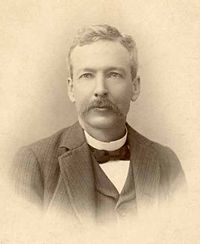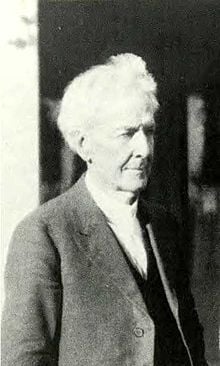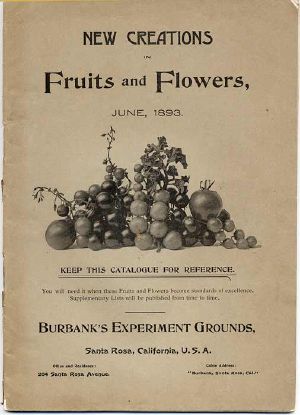Difference between revisions of "Luther Burbank" - New World Encyclopedia
(adding picture) |
(adding picture) |
||
| Line 1: | Line 1: | ||
| + | [[Image:Burbank_Shaw_c1902.jpg|thumb|right|200px|Luther Burbank - ''c1902'']] | ||
[[Image:LutherBurbank.jpg|thumb|right|220px|Luther Burbank around 1922]] | [[Image:LutherBurbank.jpg|thumb|right|220px|Luther Burbank around 1922]] | ||
'''Luther Burbank''' ([[March 7]], [[1849]]–[[April 11]], [[1926]]) was an American [[horticulture|horticulturist]]. He developed more than 800 [[Strain (biology)|strains]] and [[Variety (biology)|varieties]] of [[plant]]s over his 55-year career. | '''Luther Burbank''' ([[March 7]], [[1849]]–[[April 11]], [[1926]]) was an American [[horticulture|horticulturist]]. He developed more than 800 [[Strain (biology)|strains]] and [[Variety (biology)|varieties]] of [[plant]]s over his 55-year career. | ||
Revision as of 03:27, 30 May 2006
Luther Burbank (March 7, 1849–April 11, 1926) was an American horticulturist. He developed more than 800 strains and varieties of plants over his 55-year career.
Life and work
Luther Burbank was born in Lancaster, Massachusetts. His father, Samuel Burbank, was a farmer and a brickmaker. His mother, Olive Ross Burbank, was Samuel's third wife; the first two having passed away leaving five children. From his childhood Burbank loved plants and often gathered the seeds of wildflowers to grow at home. After finishing school and trying factory work, which was bad for his health, he bought a small plot of land and started to grow vegetables for market.
In 1872 Burbank found a seed ball on one of the potato plants in his garden. (Potato plants only rarely produce seeds.) One of the seeds produced a new variety of potato which was named the Burbank potato. Burbank sold the new potato to a seed dealer for $150. A natural sport (genetic variant) of the Burbank potato with russet (reddish-brown) skin later became known as the Russet-Burbank potato: this large, brown-skinned, white-fleshed potato has become the predominant processing potato in the United States. McDonald's french fries are made exclusively from this cultivar.
In 1875 Burbank decided to move to California, partly because three of his brothers had moved there before and partly because he felt the climate and conditions there were better for horticultural work. He settled in Santa Rosa and soon purchased a four acre plot of land on which he started a nursery business.
Burbank's real interest was not just in growing plants but in trying to improve them and make them more useful to humankind. He was inspired by the books of Charles Darwin and by the whole concept of evolution. He latter said that his one sentence from Darwin's book The Effects of Cross- and Self-Fertilization in the Vegetable Kingdom was his "starting point":
- As plants are adapted by such diversified and defective means for cross-fertilization, it might have been inferred from this fact alone that they derived some great advantage from the process; and it is the object of the present work to show the nature and importance of the benefits to be derived.
Burbank's method was to cross-pollinate plants of different varieties and even different species, to grow large numbers of the new hybrids, and to select the best plants of the new generation to start a new variety. He had hundreds of experimental plantings, and many thousands of plants, at any one time. Part of the reason for his success is these large numbers and part is his own special genius in knowing what crosses to try and which of the offspring to select for further work.
Burbank's most successful strains and varieties include the Shasta daisy, the Fire poppy, the July Elberta peach, the Santa Rosa plum, the Flaming Gold nectarine, the Burbank plum, the Freestone peach, and the Burbank potato. Burbank also bred the white blackberry and the nectarine. One his most famous creations is the spineless cactus, which provides food for both cattle and people. He had high hopes that this would revolutionize agriculture in desert regions and help to end world hunger. It was not quite the success he had hoped but it is still being grown in many places.
Burbank's creations included: Fruits
- 113 plums and prunes
- 35 fruiting cacti
- 16 blackberries
- 13 Raspberries
- 11 quinces
- 11 plumcots
- Ten cherries
- Ten strawberries
- Ten apples
- Eight peaches
- Six chestnuts
- Five nectarines
- Four grapes
- Four pears
- Three walnuts
- Two figs
- One almond
Grains, grasses, forage
- Nine types
Vegetables
- 26 types
Ornamentals
- 91 types
Thoughout his career Burbank struggled with the business side of his work. He wanted his work to be profitable but at that time plant varieties were not patentible so he had to sell the individual plants and seeds, directly to farmers and gardeners and indirectly though retailers such as the Burpee Seed Company.
Burbank wrote several books on his methods and results, including his eight-volume How Plants Are Trained to Work for Man (1921), Harvest of the Years (with Wilbur Hall, 1927), Partner of Nature (1939), and the 12-volume Luther Burbank: His Methods and Discoveries and Their Practical Application. Burbank also published in 1893 a descriptive catalog of some of his best varieties, entitled called New Creations in Fruits and Flowers'.
Other works include:
- The Training of the Human Plant
- Some Interesting Failures: The Petunia with the Tobacco Habit, and Others
- The Almond and Its Improvement: Can It Be Grown Inside of the Peach?
- Four Burbank Plums, and How They were Made: Methods Which Brought Unprecedented Success
- Corn: The King of America's Crops: Not Only Better Corn, But a Better Stalk and Why
- Twenty-three Potato Seeds and What They Taught A Glimpse at the Influence of Heredity
- Other Useful Plants Which Will Repay Experiment: Transformations and Improvements Waiting to Be Made
- How Plants Adapt Themselves to Conditions: The Influence of Environment
- The Tomato and an Interesting Experiment: A Plant which Bore Potatoes Below and Tomatoes Above
- The Rivalry of Plants To Please Us: On the Forward March of Adaptation
- How the Cactus Got Its Spines and How It Lost Them: A Sidelight on the Importance of Environment
- Some Plants which are Begging for Immediate Improvement: Some Plants which are Begging for Immediate Improvement
- Manufacturing Food for the Live Stock: Some Suggestions on Clover, Timothy and Alfalfa
- Plants Which Yield Useful Chemical Substances: Observations on Sugar Cane, Hops and Sugar Beets
- Short-Cuts into the Centuries to Come: Better Plants Secured by Hurrying Evolution
- What to Work for in Flowers: And How to Proceed
- No Two Living Things Exactly Alike: Infinite Ingenuity the Price of Variation
- Fixing Good Traits: How to Hold a Result Once Achieved
- How Far Can Plant Improvement Go?: The Crossroads Where Fact and Theory Seem to Part
- The Burbank Cherry: The Explanation of a Double Improvement
- My Life and Work with Fruits and Flowers
- Garden Culture
- Burbank's new creations and special new selections in seeds
- Proof book number 1
- How nature makes plants to our order
- Luther Burbank, his methods and discoveries and their practical application: A synopsis
- Fundamental principles of plant breeding: Production of new trees, fruits and flowers : plants and children
- Another mode of species forming
- Advance offering of pedigreed Burbank novelties: Fruits and flowers direct from Burbank nurseries, season 1912-1913
- New plants to feed the world: And other articles by and about Luther Burbank from Orchard and Farm
- The new Shasta daisies: "Alaska", "California", "Westralia"
- The fundamental principles of plant breeding
- Plant breeding (How his first plants are trained to work for man)
He also wrote two books unrelated to botany: Piecing the Fragments of a Motion Picture Film : We Stop to Take a Backward Glance and My Beliefs.
Burbank also had interests in religion and in education reform, writing "Why I am an Infidel" in E. Haldeman-Julius' Little Blue Book #1020. He befriended Paramahansa Yogananda during the last several years of his life. Yogananda wrote about Burbank in chapter 38 of his autobiography, describing him as the ideal of an American saint. Yogananda even dedicated his autobiography 'To the Memory of Luther Burbank, An American Saint'
In mid-March 1926, Burbank became ill with gastrointestinal complications. He died on April 11, 1926, and is buried near the greenhouse at the Luther Burbank Home and Gardens.
Legacy
Burbank's work spurred the passing of the 1930 Plant Patent Act four years after his death. The legislation made it possible to patent new varieties of plants (excluding tuber-propagated plants). In supporting the legislation, Thomas Edison testified before Congress in support of the legislation and said that "This [bill] will, I feel sure, give us many Burbanks." The authorities issued Plant Patents #12, #13, #14, #15, #16, #18, #41, #65, #66, #235, #266, #267, #269, #290, #291, and #1041 to Burbank posthumously.
In 1986, Burbank was inducted into the National Inventors Hall of Fame. The Luther Burbank Home and Gardens, in downtown Santa Rosa, are now designated as a National Historic Landmark.
The town of Burbank, California, does not take its name from Burbank, but from the Los Angeles dentist David Burbank; however, the horticulturist gave his name to Luther Burbank Middle School in Burbank. The Luther Burbank School District in San Jose and Santa Rosa's Luther Burbank Rose Parade and Festival also honor Luther Burbank. Santa Rosa used to have a performing arts center named after Burbank, but Wells Fargo bought naming rights for $3.2 million in 2006 and renamed it. The Lancaster Middle School in Lancaster, Massachusetts was renamed to Luther Burbank Middle School in 2003.
The University of Wisconsin Digital Collections Center has digitized and published online the 12-volume monographic series Luther Burbank: His Methods and Discoveries, which documents Burbank's methods and discoveries and their practical application.
In 1931 the Boys Parental School located on Mercer Island, Washington changed its name to Luther Burbank School. The school continued to function until 1966. The land on which the school was built was bought by King County and converted into Luther Burbank Park.
The standard botanical author abbreviation for Burbank consists simply of "Burbank".
ReferencesISBN links support NWE through referral fees
- Kraft, Ken & Pat. Luther Burbank, the Wizard and the Man. New York : Meredith Press, 1967
- Yogananda, Paramahansa. Autobiography of a Yogi. Los Angeles : Self-Realization Fellowship, 1946 ISBN 0876120834
External links
- Luther Burbank Home and Gardens official website
- National Inventors Hall of Fame profile
- Wells Fargo Center for the Arts (formerly the Luther Burbank Center for the Arts)
- UN report on spineless cactus cultivation in Tunisia
Credits
New World Encyclopedia writers and editors rewrote and completed the Wikipedia article in accordance with New World Encyclopedia standards. This article abides by terms of the Creative Commons CC-by-sa 3.0 License (CC-by-sa), which may be used and disseminated with proper attribution. Credit is due under the terms of this license that can reference both the New World Encyclopedia contributors and the selfless volunteer contributors of the Wikimedia Foundation. To cite this article click here for a list of acceptable citing formats.The history of earlier contributions by wikipedians is accessible to researchers here:
The history of this article since it was imported to New World Encyclopedia:
Note: Some restrictions may apply to use of individual images which are separately licensed.


